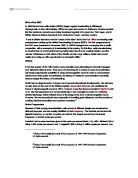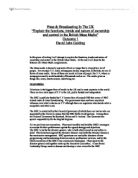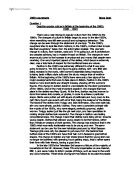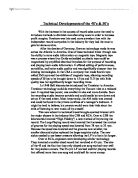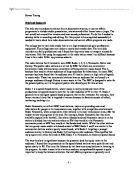Television Institutions.
When we home from school, work or aver fining we switch on the television to watch a particular programme. We have certain expectations that the programme will start and finish at a specific time. We see television as it is a normal part of everyday life. Like reading a newspaper, shopping or going to school. One of the biggest channels is BBC. BBC is funded through the licence fee. Everyone in England how has TV must pay for this licence. This licence pays for the programmes on the BBC and on the radio stations owned by the BBC (radio 1, 2, 3, 4 and 5). There are no adverts on the BBC or these radio stations. It is a non-commercial (not there to make a profit) stations whereas ITV, Channel 4 and Channel 5 are commercial stations (there to make profit). Channel ITV, channel 4 and channel 5 are been owned by large moneymaking organisations whose aim is to make profit for their shareholders. So they charging advertisers large sums of promote their products on these stations (usually six minutes of adverts per hour). SKY and cable have no restrictions on how many adverts they show in any hours, therefore, have far more adverts as this means more profit for theme. Most of the channels complement with each other, for example on Thursday the 20 of April on ITV there is Emmerdaleand at 7.00o'clock and on BBC1 there is watchdog with Anne Robinson at 7.00. Then at on 7.30 on BBC1
Analysis of the Army's Media Campaign
Media Assignment In Today's society many different mediums exist; television, radio, internet and newspapers. To stand out in such a competitive and difficult environment an advert must be eye-cathing, engaging and memorable. It must reach the people you want it to and inform them (often in a biased way leaning their opinions towards yours.) By doing so companies and organisations hope to increase sales of a product or use of a service, or in the case that we are examining, encouraging people to join The Army. In the television advertisement the promotion is presented in a formal news programme by Lisa Aziz, a recognisable news presenter. Also "on location" in Bosnia and at an Army Barracks are Kate Adie and Chris Seurle, Kate Adie is a very well known BBC news reporter adding to the feeling of the promotional video being reputable. At the very beginning of the video the director has used a sequence of very interesting action shots showing what you could be doing if you joined The Army and keeps a theme that The Army is different now but will be keep changing. The Video then goes on to display the good deeds that The Army does and also interviews some recruits who have experienced The Army and say only good things about it The Promotional Video is aimed at parents of recruits who might be worried about their son or daughter joining The Army. In
Birth of the BBC
Birth of the BBC In 1920 the first true radio station (KDKA) began regular broadcasting in Pittsburgh, Pennsylvania, in the United States. Within two years the number of stations in America reached into the hundreds, concerts were being broadcast regularly in Europe from The Hague, and in Britain, Marconi stations broadcast from Chelmsford, Essex, and then London. It was in Britain that fears over the "chaos of the ether" led to the Post Office and leading radio manufacturers setting up the British Broadcasting Company (BBC). The first programmes by the BBC were broadcast in November 1922. In 1926 it changed from a company into a public corporation, with a monopoly of broadcasting in the country. By this time, radio manufacturing in America had for a brief period been growing faster than the car-making industry, and the number of listeners on both sides of the Atlantic ran into many millions. Radio had moved rapidly from being an attic experiment to a household utility.1 History In the last quarter of the 19th century many scientists were attempting to transmit messages over distances without wires. They were not searching for a means of mass-communication, but simply exploring the possibility of using electromagnetic waves in order to communicate between two fixed points. Nevertheless, the history of "wireless" communication eventually became largely the history of
Explain the functions, trends and nature of ownership and control in the British Mass Media
Press & Broadcasting In The UK "Explain the functions, trends and nature of ownership and control in the British Mass Media" Outcome 1 David John Golding In this piece of writing I will attempt to explain the functions, trends and nature of ownership and control in the British Mass Media. At the end I will describe the features of a Mass Media conglomerate. The Mass media is basically any style of text or image that is viewed by a lot of people. For example T.V, radio, newspapers, books, magazines, billboards, etc are all forms of mass media. Some of these can reach millions of people like T.V, where as newspapers usually reach hundreds of thousands and so on. The media gives us things like, news, entertainment, advertising etc. TELEVISION: Television is the biggest form of media in the UK and in most countries in the world. There are two main types of T.V in the UK, public funded and independent. The BBC is publicly funded by T.V licence fees of around £100 that cover all BBC related audio & visual broadcasting. The government does not have any direct influence over what is shown on T.V although there are regulators who decide what is acceptable and what is not. The BBC is controlled by their board of governors of which there are twelve who are appointed by the Crown to ensure that the BBC fulfils its obligations. Among them are National Governors for
Describe popular culture in Britain at the beginning of the 1960's (1960 - 1965) There was a vast change in popular culture from the 1950's to the 1960's. The changes
Describe popular culture in Britain at the beginning of the 1960's (1960 - 1965) There was a vast change in popular culture from the 1950's to the 1960's. The changes of culture in Britain began to occur in the late 1950's, when everything was still seen as adult and outrageous behaviour. This change can be seen through the statement of one lady: "In the 1950's, daughters tried to look like their mothers, in the 1960's, mothers tried to look like their daughters," taken from the information booklet. This dramatic change in culture, from fashion, radio and TV to going out, art & architecture and peoples opinions, had a massive impact on Britain. The changes in were enormously down to the increase in employment and money that people were receiving. One very important aspect of the sixties, which became extremely clear, was a total lack of respect for the traditional ideas and values. Fashion in the 1950's was extremely different to what it was soon going to become. The 50's saw figure hugging clothes, with very little skin being revealed to the world, with women's essentials being headscarfs, turbans, basic military style suits and the sturdy wedge shoe of wartime Britain. At the beginning of the 1960's there were only a few signs of the major developments that were to take place in Britain. Fashion in the 1960's became more short skirts and straight dresses, showing off the
radio station analysis
Research - Analysis of Radio Stations and Shows In this assignment I will look at a range of radio stations and programmes looking at various logistics making them what they are. I will initially look at a range of radio stations and analyse them, breaking them down into target audience, age range of audience, demographics and the social status of the listeners. I will choose two stations from the BBC and one commercial station. I have chosen to analyse only one commercial station as two commercial stations within the same region will be fairly similar in style and speech content et cetera. I have chosen Trent FM due to it being Nottingham's oldest commercial station whereas other commercial stations in Nottingham such as Heart FM are owned by corporate companies running other stations around the country such as Capital Radio and FXM. I will also choose three radio programmes, one from a local BBC station, one from a nationwide BBC station and a radio show from a pirate station. I will look at presentation of the show, speech content of the presenters, target audience and the overall style. For the analysis of radio stations I have chosen BBC Radio One and Four. This way I will have looked at each end of the scale-Radio One being quite upbeat and geared towards a younger audience and Radio Four being partly political and partly artistic-but not in a modern arts way.
History of Radio in New Zealand.
Media Studies Essay History of Radio in New Zealand Radio started in 1921 when a man named Robert Jake, from Otago University made the very first broadcast in New Zealand. Robert first broadcasted from Dunedin to Christchurch, but within 10 years of the first broadcast it went from a novelty item to an every day event. He even broadcasted the arrival of Jean Batten in New Zealand after her solo flight over the Atlantic Ocean. In the 1930's a Reverent Colin Scriminger, began to broadcast on the wireless. This man also questioned government policies on air and this scared the politicians a bit. Professor James Shelley was the Director of Broadcasting for this period of time and as he came from a high cultured background, he wanted the radio to broadcast high cultured thing such as 'worthy talks on worthy subjects'. The year of 1936 saw a woman radio announcer take the microphone. Aunt Daisy was her name and she had a morning time slot from 9 - 10am. This was the time that the 'housewives' were at home and listening to the radio, so Aunt Daisy would give house hold tips about, cooking, cleaning and the general running of the woman's side of the household. Aunt Daisy did this show for 27 years. When the government elections of 1945 came along, the government jammed Scriminger's radio station -1 ZB -. The government took this action because of worries over what Scriminger was
Technical Developments of the 40's & 50's
Technical Developments of the 40's & 50's With the increase in the success of record sales came the need to introduce methods to diminish manufacturing costs in order to increase profit margins. Nowhere was this need more prevalent than with the independent record companies in the industry for they had the most to gain let alone survive. After the demise of Germany, German technology made its way across the Atlantic to America. One of these technical break through was the ability to store audio information on magnetic tape. Magnetic tape was a process where Iron Oxide embedded on plastic tape could be magnetized by amplified electrical impulses for the purpose of recording and playing back audio information. It offered editing of performances, portability, and better audio quality and was significally cheaper than the existing technologies. In the USA a company that made Scotch tape called 3M improved the abilities of magnetic tape, allowing recording speeds of 30 ips to be brought down to 15 ips and 71/2 ips with little quality loss but significantly longer recording times. In 1948 Bell laboratories introduced the Transistor to America. Transistor technology could do everything the Vacuum tube at a reduced cost. It required less power, was smaller in size and more durable. Soon the recording studio became portable and could easily be torn down and set-up if the need
Produce an extract from a documentary series, or current affairs programme to include studio presentation, interview and either theme tune or jingle.
Brief and Research The task was to produce an extract from a documentary series, or current affairs programme to include studio presentation, interview and either theme tune or jingle. The text would last around five minutes and must sound professional. To do this I needed to develop skills in recording and editing. For this project to be completed successfully I needed to know about how radio documentaries and current affairs programs are made. The college has its own radio studio that is to a high standard and quite professional equipment. The college uses mini disks to record and transfer data. The mini disk recorders are fairly professional and I found that they were easy to transport around for interviews. I felt that using the equipment in the radio station wasn't too difficult because I use to be a radio DJ for my previous schools. The radio stations that I listened to were BBC Radio 1, 2, 3, 4, Newcastle, Metro and Galaxy. The public radio stations are all ran by BBC the others are commercial. Commercial radio stations have a convention of being entirely music based. This is because they need to attract audiences of large audiences for advertisers. In recent BBC surveys they have found that the audience over 35 tend to listen to a high ratio of speech to music radio. These two commercial stations have an audience that are biased to a younger audience although
Radio Stirling 101: Report on a Group Research Project.
Radio Stirling 101: Report on a Group Research Project Introduction In an age of information, people have an increasing number of options to access media for entertainment and information. Yet radio remains to be one of the most accessible and cost-effective conventional media, especially for people with limited financial resources such as university students. However, according to the cursory observation of the researchers of this project, the radio listening patterns of and their effects on university students have not been adequately addressed. Therefore, this research project attempts to look into both the radio listening habits and music acquisition behaviors of students in Stirling University and, where possible, to identify the co-relation between the two sets of behavioral patterns. The findings of the research provide fairly clear patterns on both the radio listening and music acquisition behaviors with some definite co-relations between them. As an empirical research assignment of the Media Research Methods course, another purpose for this project is to utilize and test the basic research techniques that the researchers have learnt in class so as to pave the way for their future academic researches. Therefore, the last section of this report is devoted to the reflections on the project in different perspectives. Methodology The research has been conducted in a




